Draw Arrows To The Following Measurements
If you'd like to get into archery as a hobby but you have no idea where to begin, we absolutely understand how you feel. A lot of people are really excited to grab a bow and start shooting, but feel confused by all the terms and equipment and measurements. After all—there's a lot to know!
With that in mind, we put together the post below to help you get started. It's a way of presenting the basics of archery, and introducing you to the sport, little by little.
On this page, we'll provide everything you need to know as a new / beginner archer. We'll go over the different bows and the gear you'll need, the shot cycle and the steps you'll take when shooting an arrow, and most importantly, how to shoot your bow and arrow safely. If you're an adult starting out or a parent looking up info on how to help you child, we've got you covered.
If you have any questions, please hop over to our "Contact" page and drop us a line, and in the meantime, good luck—and welcome to the incredible art of archery!
First Things First: The Two Main Types of Bows
First up in your "archery for beginners" class is BOWS.
There are two main types of bows: recurve bows and compound bows.
(If you're an experienced archer, we can already hear you arguing with us—yes, there are many types of bows, such longbows, crossbows, composite bows, Japanese yumi bows, and so on. Relax! We'll get there. We're talking in generalities here).
Recurve bows look like this:
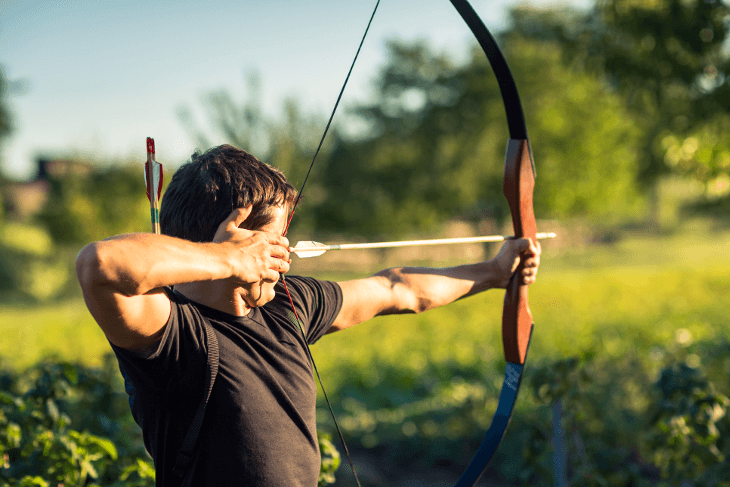
...and these are the types of bows you see in the Olympics. They have a sleek, graceful design and they're mostly used for target shooting, although some experienced hunters use them for bow hunting.
While they look pretty simple—as you can see, it's just a handle (called a riser, which we'll talk about in a minute) and an upper limb and a lower limb that connect to the bow string—there's actually a lot of physics involved, and a well-crafted recurve bow can shoot with astonishing accuracy.
Recurve bows are a little simpler than the next type of bow, which would be...
Compound bows. Compound bows look like this:
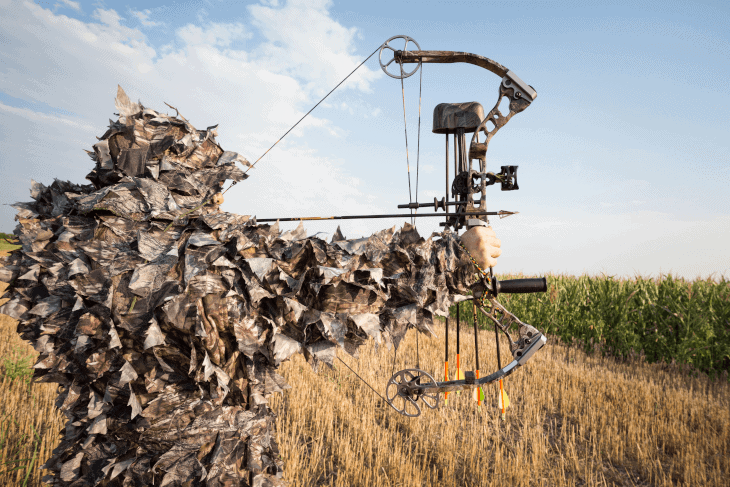
These bows are a favorite among bowhunters, because they are able to shoot with incredible speed and force. That said, there are plenty of people who use compound bows for target shooting and competition shooting, like the woman below:
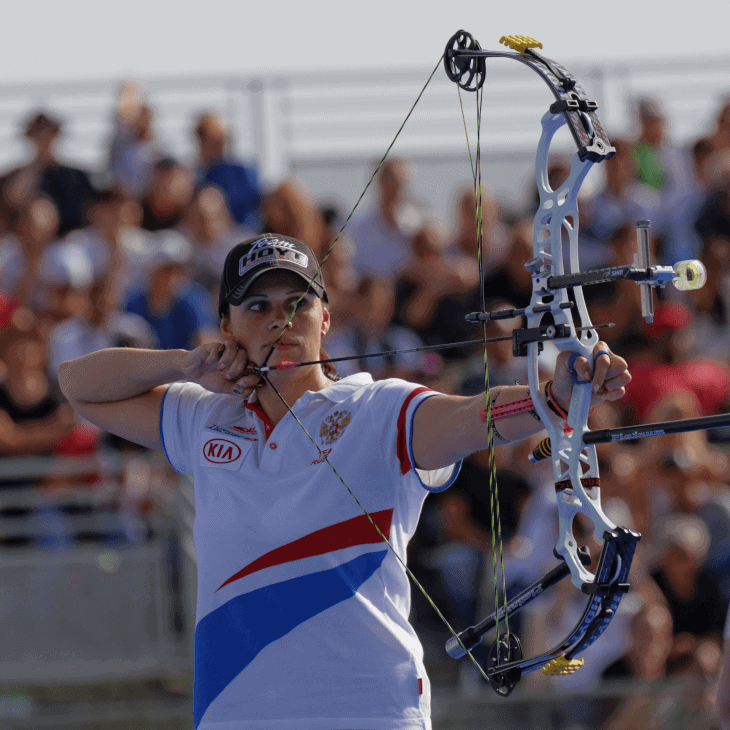
If you look at the top and bottom of the bow, you'll see that there are rounded wheels that hold the draw string. These are called "cams." They are part of a levering system that includes cables and pulleys that allows the bow to multiply (or "compound") the force used to push the arrow forward.
Sound complicated? It is! The compound bow is a technological marvel that was created only recently—they were invented in 1966, and when you consider that we've been bow hunting for tens of thousands of years, that's a pretty recent development.
You don't really need to know about the science of compound bows right now—bows are fairly simple to use, but the physics behind them gets fairly complicated—but if you're interested, we've written extensively about the physics of compound bows, and you can read about that later on.
If you go to an archery range—and we'll talk about ranges in a second—you'll see archers using both types of bow.
Next up in our "archery for beginners" course:
Parts of a Bow: The Basics
Before we get off the topic of bows, here are some terms you'll hear when you talk about bows. The parts below refer to both recurve bows and compound bows:
- The Riser. This is the handle of the bow; it's what you hold when you shoot. Risers get complicated, but here's what you need to know right now: the riser features the arrow rest, which is where you place your arrows before drawing. Recurve bows usually have an elevated rest (which is basically just a platform that the arrow sits on—you can see one here), and compound bows usually have a containment rest (which you can see here). One of the most popular types of containment rests is called a "whisker biscuit."
- The Limbs. These are attached to the riser; they form the actual bow, with the top limb attached by the bow string to the bottom limb. You'll often hear the term "takedown bow" when you're talking about recurve bows—this is a bow where you can detach the old limbs, and replace them with newer, heavier limbs. Takedown bows are great for beginners, because you can put new limbs on the bow as you develop strength and accuracy.
- The Bow String. This is the string that shoots your arrows; it connects the top limb of the bow to the bottom limb of the bow.
- The Nock Point. This is the spot on the bow string where you place the end of the arrow. The nocking point needs to stay in the same place, so that you can aim and shoot consistently.
- The Bow Sight. The bow sight is kind of like the scope on a rifle—after you adjust it properly, the sight allows you to aim at your target. Many bows come with sights, but many archers opt for an upgrade. Sights are usually attached to the riser, and you can attach/detach them whenever you want.
If that all seems like a bit much, don't worry about it! You'll understand the details of those terms in no time.
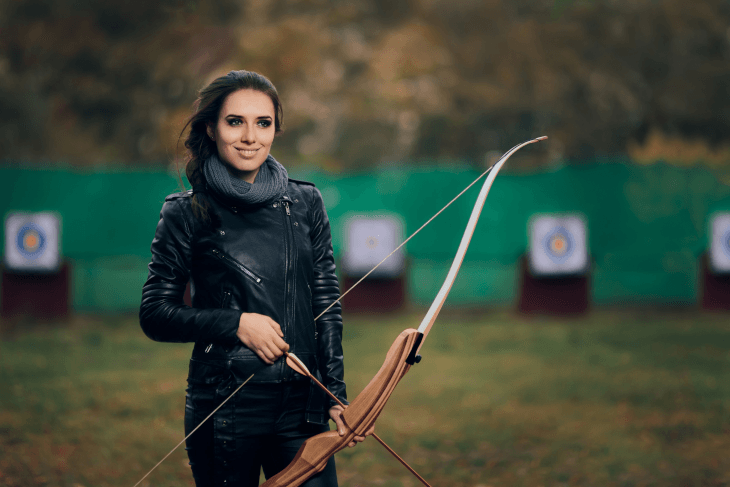
Which Type of Bow Should You Use When You're Starting Out?
This is a great question, and we'll split our answers into two parts:
If You're an Adult Choosing Your First Bow for Yourself…
There's no right answer, but here are the main things to keep in mind:
In general, recurve bows are easier to buy and use. You just need to get your measurements right (and we help you with that below). They need less tuning, and with many models, you can put them together "right out of the box" and start shooting. That sort of simplicity is fantastic for a new archer, and you can dive right into the sport.
Compound bows, with their cams and accessories, can be a little more difficult to tune, and if you buy one online, you may need to bring it to a brow shop or archery range and have them tune it for you (some models have videos on YouTube that show you what you need to do, though, and that can make things a lot easier). The benefit of compound bows is that once you get them tuned right, they can be a lot easier to aim and shoot, and they make it a lot easier to hit your target. For most archers, consistently hitting your target is deeply satisfying!
But, as we said… there's no right answer, and the choice is up to you! If you're drawn to compound bows, use compound bows; if you like the look of recurve bows, start with a recurve bow. There's no right answer—it's totally up to you, and many archers use both over the course of their lives.
As we mentioned above, people who are interested in target archery generally use recurve bows, which are designed to enhance form and accuracy, and people who are interested in bowhunting generally use compound bows, which are designed to be short and transportable through hunting environments, and shoot arrows that are blistering fast and powerful.
But, that said—those are generalities. There are plenty of target archers who enter competitions where the contestants use compound bows, and plenty of hunters who train extensively and use recurve bows made for hunting.
And, there are a LOT of folks—the good people who write for this website included—who have fallen in love with both target archery and bowhunting, and who shoot both recurves and compounds.
If You're An Adult Choosing A Bow for Your Child or Young Adult…
Either will do, and if the bow isn't a surprise gift, it's always a good thing to show your child both types of bows to see which one they're interested in.
That said, as far as *interest* goes, it seems that the general trend is that boys seem to be more interested in compound bows, and girls seem to be more interested in recurves.
We don't know why it seems to play out that way, and we don't really have any idea why boys seem more interested in compounds, but for girls, our *guess* is that it has to do with the recent string of female heroes who have used bows. In most cases, the heroine is using a recurve—Katniss Everdeen from The Hunger Games used a recurve, as did Merida from the Disney movie Brave—and younger female archers may have recognized that.
Again—that's just our observation, made after talking with hundreds of parents, but it's definitely not a hard and fast rule—there are plenty of boys who love recurves and girls who love compounds.
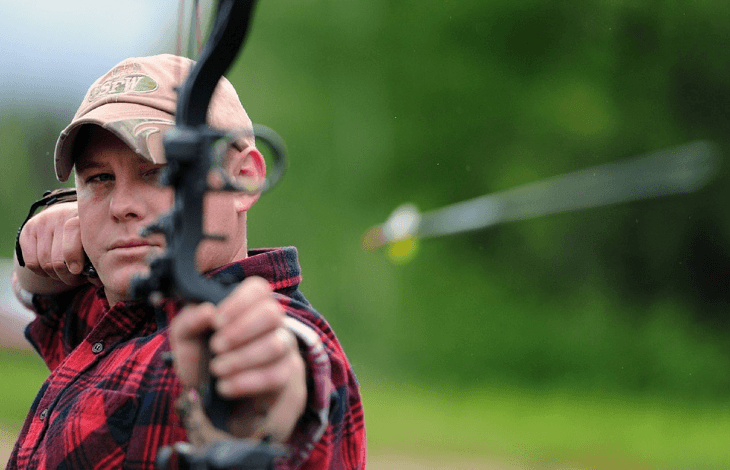
Our Bow Recommendations for New Archers
We've looked at a lot of bows over the years, and there are two that we consider the best options for new archers.
Recommendations for Adults

Samick Sage Takedown Recurve Bow (25 LB., Right)
- ERGONOMICALLY DESIGNED - Samick's risers are manufactured with imported Maple wood, for lightweight and highly durable bows, with a comfortable ergonomic grip.
- FEATURES - Pre-installed threaded Brass Bushings for various attachments and upgrades, such as, Brass Plunger, Stabilizer, Sight, Quiver, Bow fishing reel.
- HAND ORIENTATION - Right Handed - Hold the bow with your LEFT hand and pull the string with your RIGHT. Left Handed - Hold the bow with your RIGHT hand and pull the string with your LEFT.
For recurves, we almost always suggest the Samick Sage Recurve Bow. We love it. It's easy to use, easy to set up, and it's easy to accessorize—you can add a arrow rest and a bow sight without too much effort. Plus, it's a "take-down" bow, meaning that if you want to increase or decrease the strength of the bow, you can remove the limbs and install new ones. It's sturdy, reliable, and many archers have used it to get from the "beginner" stage to the "intermediate" stage. It's a great option for adults, but also for young adults.
For compound bows, we like the Predator Raptor Compound Bow. It's got an adjustable draw weight—meaning that you can begin at a lower draw weight when you start out (and on the Raptor, that's 30 pounds), and increase the weight as you gain strength and ability (and if you don't know what draw weight is, keep reading! We describe it below). It's manufactured with some great gear—a five-pin bow sight, a stabilizer to give the bow some steadiness, and a whisker biscuit rest—all of which you'll need to begin. Because of its adjustability, we think it's a great option for folks just starting out in archery.
Recommendations for Young Adults and Kids

For younger kids, we usually recommend the Easton Youth Beginner Recurve Kit. It's got an "ambidextrous" design, meaning it's good for righties and lefties, the bow string is easy to pull back, and it comes with some gear—three arrows, a hip quiver to keep them in, and an arm guard (a must-have for shooters of all ages), and a finger tab (for pulling the string back). For recurve bows for young adults, we recommend the Samick Sage (see above). It's a fantastic bow your teen/young adult can grow with.

GENESIS Kit - RH Black
- Official bow of the National Archery in the Schools Program (NASP).
- Great starter bow for archers of all ages, sizes and athletic abilities. With no specific draw length requirement, kids can't outgrow this bow.
- Includes a machined 6061-T6 aluminum riser, aluminum cam and idler wheel, sturdy composite limbs and high-strength bowstrings – all made in the USA.
For compounds, we're big fans of the Genesis Original Kit. It's a good option for new archers of all ages, and it's got an adjustable draw weight ranging from 10 to 20 pounds, and it's very easy to use. That's a good thing, because compound bows can get pretty complicated. It also comes with some gear—a quiver, an arm guard, five aluminum arrows, and a hex wrench that you can use to adjust the draw weight of the bow.

Bear Archery Brave Bow Set
- 26" axle-to-axle introductory bow comes ready to shoot with two Safetyglass arrows
- Set also includes Whisker Biscuit, 1-pin sight, finger rollers, armguard, and arrow quiver
- Whisker Biscuit is the safest rest in archery industry and a $40 value.Care-hand wash
If the Genesis Original doesn't do it for you, we usually recommend the Bear Archery Brave Bow Set. It's just as easy to use, and it comes with an armguard, which is fantastic—we wish all beginners/kids bows came with armguards!
By the way, if you'd like to read more, you can check out our post on the best recurve bows for beginners, and our post on the best compound bows for beginners.
Now that we've talked about some good options, we've come to the hard part: your measurements. In order to find a bow that you can shoot safely, you'll need to learn how to find a bow with the right settings. This can be something of a challenge for new archers, so if the following sections get a little confusing, have no fear—mostnew archers get a little confused when first taking their measurements, so don't worry about it if you get a little tripped up. Re-read the sections that give you a little trouble, and if you have any other questions, jump over to our "Contact" page and drop us a line.
Measurements: How to Get the Right-Sized Bow for You
There are two main measurements you'll need when selecting your first bow: draw length and draw weight. Let's discuss each.
Draw Length. The first measurement, draw length, refers to distance to which you can comfortably pull back the bow string. Draw length is important because in order to make accurate shots, you need to draw the bow string back the same distance for each shot, every time you shoot. Taller people typically have a long draw length, and shorter people typically have a shorter draw length.
There are two ways to determine your draw length:
1) Go to an archery store and have a bow tech measure you with a tool called a "draw length indicator shaft." The tool looks like a really long arrow, but it has measurements on it, and the bow tech will be able to determine your draw length using it.
2) Take your height, in inches, and divide by 2.5. If you are, say, six feet tall, that means you're 72 inches tall (6 feet x 12 inches = 72 inches), and 72 divided by 2.5 = 28.8. So if you're six feet tall, you'd select a bow with a draw length of 29 inches (draw length in measured in full inches, so you'd round up from 28.8 to 29). Taking your height in inches and dividing by 2.5 is remarkably accurate, and seems to work for most people.
Draw Weight. This is the second measurement you'll need to consider when buying a bow. The draw weight is a measurement, in pounds, of how difficult it is to pull the draw string back. A bow with a draw weight of 10 pounds will be very easy to pull and shoot, and a bow with a draw weight of 50 pounds or more will be more difficult to pull and shoot.
As a general rule of thumb, children up to the age of 18 are good with bows that have a draw weight from 5 to 20 pounds (and 18 year olds may be able to draw more than that); young adults between the ages of 18 and 21 do well with a draw weight between 15 and 30 pounds (and again, stronger 18 to 21 year olds may be able to draw more than that), and adults 22 and older usually use bows with draw weights of 25 pounds and higher. These numbers are generalizations, though, and you'll learn more about your draw weight capability as you gain more experience.
Recurve bows may have a "set" draw weight, meaning, if you buy a bow with a 25-pound draw weight, that's the bow's draw weight, forever and ever. This is usually the case for recurve bows where the limbs are permanently attached to the riser. Some recurves, however, have limbs that you can remove and replace with lighter/heavier limbs—thereby adjusting the draw weight of the bow. These limbs are called "takedown limbs" (and you can see our "Parts of a Bow" section for more). If you're a new archer, a bow with takedown limbs is a great option, because with time and practice, your strength will increase, and you can use takedown limbs to make your bow more powerful.
Compound bows, on the other hand, are usually adjustable by design, and you don't need to buy replacement limbs to make them heavier or lighter. That's a big benefit for a lot of archers—you can buy one bow, and if its adjustability range is broad enough, you can simply increase the draw weight as you need to.
Before we wrap up, there's another factor you'll want to consider when you're buying a bow, and that's what hand you'll hold the bow in. For the most part, righties will use a right-handed bow (and a right-handed bow is one that you actually hold in your left-hand, and use your right hand to draw the bow string), and lefties will use a left-handed bow (and a left-handed bow is one that you hold in your right hand, and use your left hand to draw the bow string).
Additional Gear for Bows / Bow Packages
Archery is a gear-heavy sport, and while you now know a good bit about bows… there are some other things you may need before you jump into archery! Here are some additional tools you may want to look into.
Arm Guards. We'll start with the most important bit of gear first: arm guards. This is a piece of protective gear you wear for whatever bow you're using (in other words, for bow recurves and compounds), and it shields your inner arm from getting him with the bow string after you release an arrow. Getting hit with the bow string doesn't sound like a big deal, but it can be incredibly painful, and give you a huge, three-dimensional bruise. There are some very good arm guards on the market; we like the SAS Arm Guard because it's thick and provides a lot of coverage. It's got buckles, though, which some people don't like, so we also suggest the OMP Mountain Man Arm Guard, which has straps and Velcro, and can be a little bit easier to adjust.
Bow Releases and/or Tabs. These are tools that allow you grab the draw string when you pull it back to shoot an arrow. You can use your fingers to do so, but doing so will result in a lot of pain (and a lot of missed shots!).
Bow releases for recurves are pretty simple, but most people either use a glove (we like the Archery Max Leather Glove, because it's super-comfy and stays in place) or a tab (and we like the CyberDyer Leather Tab). Bow releases for compounds get pretty complicated, but the option we usually recommend for beginners is the TruFire Edge Foldback Release. It's got a trigger release which feels pretty natural, it's got a dual caliper designed to enhance accuracy, and you attach it to your wrist, which makes it easier for beginners.

Bow Sights. As we mentioned above, these help you aim. Recurve bows don't usually come with a bow sight, and we like the Recurve Bow Sight, because it's easy to install, easy to use, and you can adjust it after every shot. Compound bows often do come with a bow sight, but if your chosen bow does not, we like the Archery Essentials Bow Sight. Bow sights for compound bows can get super fancy, but this is an easy-to-use, easy-to-adjust model.
Quivers. There are a lot of different types of quivers available—hip quivers, back quivers, and quivers you can attach directly to your riser—but hip quivers are the most common for target shooting, and we like the Easton Flipside Hip Quiver. It clips to your belt or pants, has a few compartment for tools or whatever, and it comfortably holds a dozen arrows. NOTE: If you're buying a compound, be sure to check if a quiver comes with the package. Quivers used for bowhunting often attach to the riser, and they're a common add-on when you buy a compound bow.

Easton Flipside 3-Tube Hip Quiver
- Reversible hook and loop pocket for ambidextrous use
- Integrated accessory attachment grommet, belt clip attachment and bow square slot
- Color is Black
And, lastly, perhaps the most important piece of gear… arrows! We'll give this its own section, because…
A Bow Isn't a Bow Without an Arrow
So we've talked about bows. What about arrows?
There are three main types of arrows: aluminum, carbon, and wood. Each has specific qualities and specific uses:
- Aluminum Arrows. These are great for beginners, and they can be used by people who shoot from a recurve bow, as well as by people who shoot from a compound bow. If you go to the range, you'll probably see a lot of aluminum arrows.
- Carbon Arrows. These are popular with hunters, and are very popular with people who use compounds bows (although you can also use them with a recurve).
- Wood Arrows. The original arrow! If you decide to get into traditional archery, you'll learn to love wooden arrows, and eventually you'll learn how to make your own. That's pretty cool. You can use wooden arrows with a recurve bow, but they're more delicate than aluminum and carbon, so you shouldn't use them with a compound bow, because as we mentioned above, compound bows push arrows with incredible force, and wooden arrows can't always withstand the pressure of a compound bow.
Here are some terms you'll probably hear when you're talking about arrows:
- Arrowhead. This is the pointy part at the front of an arrow. Arrowheads can be different weights (and that's important; we'll talk about that in another post) and different shapes, ranging from very blunt to super, super, super sharp. As a new archer, you'll most likely be using "bullet point" arrows, which are come to a sharp—but not extremely sharp—tip. You may hear the term "broadhead" from time to time—those are the arrowheads that bowhunters use for game. They're extremely sharp and extremely dangerous, and most archery ranges don't allow them.
- Shaft. This is the length of the arrow—the part between the arrowhead and the fletching.
- Fletching. These are the vanes on an arrow; sometimes they're made of feathers (this is good for target practice) and sometimes they're made of plastic (and this is good for hunting). Usually, there's one vane on the arrow that's a different color than the other two vanes, and that's called the index vane.
- Nock. This is the back bifurcated end of the arrow, that fits into the bow string.
If you're looking for recommendations, there are two arrows we like for beginners: Easton Jazz Aluminum Arrows (they're feather-fletched, pretty durable, and great for practice), and the Carbon Express Maxima RED (these are verysturdy, have plastic vanes, are manufactured to a high degree of straightness, and can handle shots from high-poundage bows).
Sale

Carbon Express Maxima RED Fletched Carbon Arrows with Dynamic Spine Control and Blazer Vanes, Size 250, 6-Pack
- LAUNCHPAD PRECISION NOCK - Launchpad Precision Nocks come standard on all Maxima RED arrows and shafts to deliver a controlled arrow release, better shaft alignment and more consistent accuracy shot after shot.
- DYNAMIC SPINE CONTROL - Patented hi-tech carbon material construction that manages Dynamic Spine in a new way to make broadheads fly better. Maxima RED uses different carbon materials to control arrow flex to the RED ZONE.
- REAL STRAIGHTNESS - Laser checked for straightness to a remarkable 1/10,000 of an inch; Straightness of +/- 0.0025-inches is a maximum measurement, not an average
Believe it or not, arrows are one of the more complicated aspects of archery, because every archery company that makes arrows has different weighting systems, measuring systems, and so on. But, if you're raring to go, we've written a lengthy post about arrows and how to select them.
Where You Can Get a Bow and Arrow
There are pro shops all over the United States and Canada, and most carry hundreds and hundreds of different archery products. Some pro shops have salespeople who know what they're talking about, although sadly, some pro shops have salespeople who have no idea what they're talking about, and are just trying to sell you stuff. It's wise to read up on archery before you go to a pro shop, so you can tell the difference between a good salesperson and a salesperson who doesn't know his head from a hole in the ground.
You can also buy archery supplies online. There are a fair number of "big-name" online stores that carry archery products, but there are plenty super-specialized archery and bowhunting company and outfitters that you can buy from. The reviews on these sites can be very, very helpful, especially because there are literally thousands of companies that make archery products, and you may eventually want to buy a product from a company you've never heard of.
So, you've got the option of pro shops and online retailers. However, if you're not ready to buy a bow, you can simply go to the range—have we discussed ranges yet? No? We'll get to that in a minute—and you can rent your bows and arrows there. For beginners, that's a GREAT option, because it can be difficult to tell what size bow you need, the type of arrows, and so on. When you show up to the range, they'll give you exactly what you need, and you can jump in head first.

The Shot Sequence: How to Shoot
No matter what kind of bow you're using, and no matter what your skill level you're shooting at, archery is a sport about process. To shoot a bow and arrow, you must follow a sequence of steps—and the more you practice those steps, the better you'll get.
The shot sequence is a big topic, and there's too much to talk about for us to shrink it into this post, so we've written about each of these steps in great detail, and you can hop over to our "How to Shoot a Bow and Arrow" post to get started. We'll provide you with all the "pre-shot" steps, like how to determine your dominant eye, where to place your feet, and how to hold the bow, and then take you step-by-step through the shot itself.
Some Intro Rules You Should Know About
Archery is practiced by adults and kids all over the world, and when everyone follows proper safety precautions, it can be a very fun, very safe pastime.
With that in mind, there are some rules you'll want to keep at the front of your mind at all times. They include, but are not limited to...
Always Follow the Rules of Your Range. Your range has rules, and you need to learn them and follow them;
Always Shoot with Proper Form. Archery is a sport based on repetition—if you're shooting improperly, you can injure yourself over time;
Wear Appropriate Clothing. In other words, DON'T wear clothing that can interfere with your shot, and injure you or others. Loose clothing and loose jewelry are no-nos, as are open-toed shoes, and you'll need to keep long hair tied up;
Wear Appropriate Protective Gear. That usually means arm guards and bow releases, but if you're playing Archery Tag, it means helmet (and whatever else your range requires);
Damaged Gear is Dangerous Gear. Don't shoot arrows that are broken or damaged, and always check your bow to make sure it's in tip-top shape;
Never Dry Fire Your Bow. "Dry firing" is pulling back the bow string and releasing it without an arrow, and it's another big no-no. Doing so can damage the bow and send parts (sometimes sharp parts) flying everywhere, and that makes it dangerous for you, too; and
Only Aim at the Target. Always operate with the idea that you'll hit what you aim at, so only aim at the target, and never point the bow—drawn or not—at anything you wouldn't want to hit.
We've written extensively about each of these rules (and others), and you can check them out in our "Commandments" category.
Great… Now Where Do I Go to Learn Archery?
We'll start with one of our favorite locations:
Archery Ranges: The Easiest Way to Get Started
The easiest way to get hands-on experience and professional guidance is to go to your nearest archery range. Many ranges require you to take an introductory safety class (here's an example), where you'll quickly learn the proper way to hold a bow, draw, aim, and so on. You'll be amazed at what a single session will do you for you—you'll walk into the range a novice, and you'll walk out of the range... well, you'll still be a novice, but you'll probably have hit the target a few times and you may feel pretty great about yourself.
Plus—here's the true value of a range: they'll give you the equipment you need to shoot for a few hours. They'll allow you to rent a bow that fits your size specifications, give you arrows that match the bow, and place a target at the appropriate distance. That alone is worth the price of admission, because choosing equipment when you're a beginner can be quite difficult.
So where is your nearest range? Luckily, there's a fantastic site that has a state-by-state index of range locations. Archery 360 is a site run by the Archery Trade Association, and they have a terrific database of archery ranges in every state. Their page here will tell you the closest archery stores and ranges near your house.
If you do get involved in archery, the range may become your favorite place. Not only will you have access to archery leagues and some amazing classes (the range near us has a axe-throwing class—how cool is that?), you will very likely meet like-minded people who can teach you a lot about target shooting and hunting. For many people, the range starts out as a place to learn, and quickly becomes a place to hang out with friends.
On-Your-Own Learning
If you catch the bug and want to learn as much as you can about archery, there are some fantastic sites dedicated to archery that you can visit. The best one is: this one, obviously! We've tried to create a site that truly helps beginners go from 100% green to capable archers, so if you have any feedback on how we can make this site better, we'd love to hear it—jump over to our "Contact" page and send us a note.
There are other sites, of course, and some are pretty darn fantastic. Here are some of our favorites:
Archery 360. We mentioned these guys above. It's got some excellent how-to videos, interviews with pros and Olympians, and magazine-style articles about topics of interest (ie, "Five Epic Spots for Archers Who Love to Travel" and "10 Archery Costumes We Love").
NUSensei's videos on YouTube, located here. NUSensei truly loves the sport of archery, and has dozens of in-depth, helpful videos about equipment, form, and style. Plus, he's got a great sense of humor, and that makes a huge difference, because there are some very, very dry archery teachers out there. Fun Fact: NUSensi has a goal of attending the 2020 Olympics, and has kept a strict training regimin to get him there. Go, NUSensei! We're rooting for you.
The "Archery" subreddit at Reddit.com. Yes, there are some archery snobs there, but very few—the overwhelming majority of folks in the community are super-nice and super-helpful. It's updated every day, and it's definitely worth a visit.
Last Thing—What About Kids?
A *lot* of the visitors to this site are parents, and that is AWESOME. Archery is an incredible parent-and-child sport, and we're glad you're here.
Here are the #1 and #2 questions we get from parents who visit our site: Can my kids get involved in archery, and is it safe?
Question #1: Absolutely! There are many, many kids who learn archery at a young age, and there are actually leagues kids can join. JOAD (Junior Olympic Archery Development) is a program for kids 8 to 20, and has programs in every state in the U.S. We've written a post about getting kids involved in archery, and you can find that here.
Question #2: Archery can be safe AS LONG AS THERE IS A PARENT OR GUARDIAN AROUND, WHO KNOWS WHAT HE/SHE IS DOING, AND IS PAYING CLOSE ATTENTION.
We gave you the old "full caps" treatment there, because we want to be very clear: archery can be a safe sport for kids, but they NEED PROPER SUPERVISION (we just went full caps again; sorry).
Archery is a hobby, but a bow and arrow is not a toy—it is a weapon, and it can fatally harm the user or people around the user.
So, yes—archery can most definitely be a safe and rewarding sport for kids, but only when proper safety rules are followed.
You're Off to a Good Start
So now you know about the two main types of bows, a little bit about arrows, the benefits of a range, and where you can learn more as you develop your skills. You should be excited—you're off to a great start!
If you have any questions about archery, hop on over to our "Contact Us" page, and we'll get back to you as soon as we can. In the meantime, welcome to the wonderful world of archery! We hope it provides you as much joy and satisfaction as it's provided us.
Click to enlarge image

Share this Image On Your Site
Draw Arrows To The Following Measurements
Source: https://www.completeguidetoarchery.com/archery-for-beginners-how-to-get-started/
Posted by: lomaxpoccour.blogspot.com

0 Response to "Draw Arrows To The Following Measurements"
Post a Comment